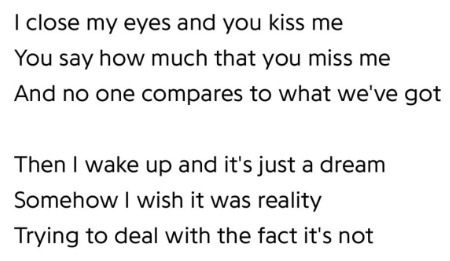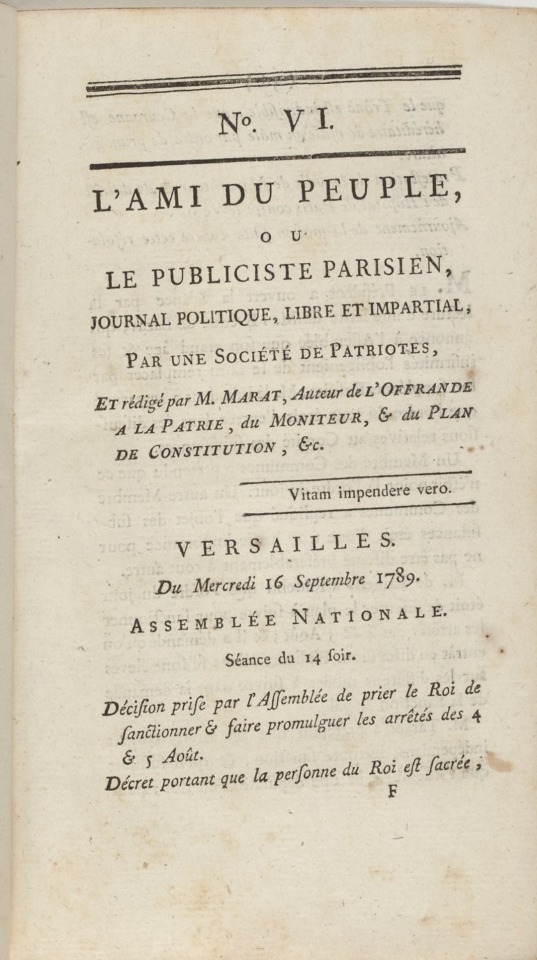#l'amis
Text

L'ami de mon amie (1987)
603 notes
·
View notes
Text

When I'm having a crappy day at work, I sometimes visit "L'Ami du Peuple" during my lunch break. It tends to put all the petty day-to-day stuff into perspective…
During the quieter moments, like today, when room 55 is nearly empty, I can't help but notice a pattern. Every single visitor, upon entering, pauses before the painting.
They do a double-take at the painting's name and give him another look. Some snap a photo they'll probably never look at again.
Then they move on.
Most of them likely have no clue who he is. They don't know he's holding a note from his assassin. If they even notice "L'An Deux" written at the bottom, they're probably confused by it.
But still, for those 30 seconds, David's brushstrokes exquisitely forming the face of this stricken man make them pause. What makes them linger? Is it the vaguely familiar name? The face they've seen on numerous posters and leaflets? The unsettling quiet brutality of the piece?
It doesn’t really matter why. Because, for that half-minute, through their eyes, he exists. He is present. He is contemporary.
#pseudo-philosophical ramblings#frev#french revolution#marat#jean paul marat#l'ami du people#jacques louis david#my happy place is a picture of a 18th century dead guy#personal opinion
100 notes
·
View notes
Text


























L'ami de mon amie / Everybody’s Fool - Evanescence / Bender: New and Selected Poems “Robert Desnos (1900-1945)” - Dean Young / Tyler Durden - Madison Beer / In My Head - Ariana Grande / Fairytale (Let Me Live My Life This Way) - Rebecca Ferguson / Costar / Dancing - Mellow Fellow / Icarus - Azra.T / Jane Eyre - Charlotte Brontë / Guillermo Decurgez / R.E.M. - Ariana Grande / Anecdote of the Pig - Tory Adkisson / All In My Head - Tori Kelly / In Real Life - Demi Lovato / Crush - Richard Siken / The Dropout / unknown / Naked Lunch / Only - Nine Inch Nails / Sun Bleached Flies - Ethel Cain / Mad Girl's Love Song - Sylvia Plath / Everywhere - Michelle Branch / Can U Not - Okay Kaya / Gunshot - Lykke Li / Alex - Roy Blair / please put me in a medically induced coma - carolesdaughter / Lucky You, Hearts/Wires, Radiant City - Deftones / Who Do You Love? - Kindness, Robyn / L’ami de mon amie
#parallels#evanescence#robert desnos#dean young#jane eyre#charlotte brontë#sylvia plath#naked lunch#nine inch nails#trent reznor#ethel cain#l'ami de mon amie#éric rohmer#eric rohmer#okay kaya#roy blair#lykke li#please put me in a medically induced coma#carolesdaughter#deftones
413 notes
·
View notes
Text

"Was Jacques-Louis David in Hell? Could he be commissioned to paint 'The Death of the Radio Demon' in place of Marat?"
maybe he cant BUT I CAN!!!!!!!!!
jk this is a gift not a com
based off of part 8 of We Should've Been Enemies by @soot-and-salt
#WOOOOOOOO#listen ive been recreating old paintings with hazbin characters for months now#i HAD TO fulfill the prophecy#also#my vocal coach started assigning me Cole Porter songs out of the blue#so i took it as a sign#9h37m#also all of those papers have actual french on them#one of them is a translatoion of L'amie du peuple to be about vox and rosie#one is an explanation of why i drew this#and one is the ao3 description of chapter 8#AHAHAHAH#hartart#hazbin fandom#alastor#radio demon#artists on tumblr#fic art#gift art#radioapple fic#duckiedeer fic#appleradio fic#everyone go read wsbe right meow#its so good
20 notes
·
View notes
Photo



Volume 4 of Machito Gomi’s Pokémon Journey manga adapatation had Iris, Denji and ~*SHIGERU*~, and my son is thriving and I’m love him (and Gou’s reactions are the best =D)
#i still have an extreme special fondness for the more serious/stern aspect of him we had seen#(with end of ag/parts of d&p)#but he was having the time of his life in journey and combining his BestTM and his WorstTM#(guiding&helping and. getting under people's skin.) <3#palletshipping#shigeru#satoshi#gou#swsh anime#jn068#si quelqu'un a oublié ou ne sait pas que shigeru est ~l'ami d'enfance~ de satoshi...#shigeru va s'assurer que vous vous en souviendrez.
172 notes
·
View notes
Text

alain delon
adieu l'ami
dir: jean herman
#<3#adieu l'ami#jean herman#alain delon#forever love#mon homme préféré#my pic#my edit#farewell friend
17 notes
·
View notes
Text

#j'ai obtenu le mot de passe d'un citoyen qui m'a trouvé#ces questions sont un peu ridicules#mais c'est le gouvernement#alors c'est normal#french revolution#frev#frevblr#unreality#committee dispatch#???#gimmick blog#marat#jean paul marat#ooc: source: l'ami du peuple no. 13#also ooc: if I fucked up the french in the tags je suis desolé#I wrote this up at abt 1 in the morning
7 notes
·
View notes
Text
September 16th, 1789: 234 years ago, Jean-Paul Marat published the first issue of L'Ami Du Peuple




L'Ami du Peuple, or, as it was called at the time it was founded, L'Ami Du Peuple ou Le Publiciste Parisien, was an active revolutionary newspaper and also one of the most absolutely fascinating and interesting pieces of the entire French Revolution, created and edited by Marat from September 1789.
The year 1789 was a relatively turbulent period for both Marat's career and the history of the Revolution. This can be seen simply by the number of projects that Marat began in a short space of time. In February, just two months after publishing his Offrande à la Patrie (1788), he published the Supplément à l'Offrande (1789). In March, he began to attend the sessions of the electoral assembly of his district, Carmes-Déchaussés, with great assiduity and was soon elected to the electoral committee. In August, he began publishing Le Moniteur Patriote and also published the Projet de déclaration des droits de l'homme et du citoyen suivi d'un Plan de constitution juste, sage et libre. Finally, in September, he published No. 1 of Le Publiciste Parisien, and consequently No. 5 of the then L'Ami Du Peuple ou Le Publiciste Parisien, which marked the birth of the famous Friend of the People, a character Marat would identify with until the last day of his life. It can be said that this newspaper came about when Marat found himself in a situation where he would have to produce and publish newspapers and pamphlets independently and without the approval of his colleagues. He proposed to the committee that it should have a press, which was apparently not accepted by the district.
More than just one of the many periodicals that existed during the course of the revolution, L'Ami du Peuple is a precious historical source of information and there is no doubt that it was important for the unfolding of revolutionary events. Not even Delisle de Sales, in his Essai sur le journalisme depuis 1735 jusqu'à l'an 1800 (1811), a work that expressed the author's deep aversion to the revolutionary process and especially to Marat, denies that L'Ami Du Peuple left a mark on the philosophical memory of the history of French journalism.
Albert Mathiez, in a summary of Gottschalk's Marat in the 1927 AHRF (pp. 599-602), makes an interesting comment on Marat's analysis in the context of revolutionary journalism:
"In my opinion, what makes Marat original among the journalists and statesmen of the Revolution has not been sufficiently appreciated by M. Gottschalk. (...) He was never naïve about the revolution that was taking place. From the first moment, he proclaimed that the proletarians - an expression he had already used in its current sense - would gain nothing. (...) No other revolutionary had the same degree of feeling that the proletariat was a class distinct from the bourgeoisie. (...) What always distinguished Marat, presented as an enlightened man, was the correctness of his vision, the total absence of candor, the profound and even pessimistic realism. Marat was not only one of the most determined and precocious republicans. He also did not conceive of the Republic except in the form of direct rule."
In addition to the abundant and impressive number of issues that were written (L'Ami du Peuple had almost 700 issues in total, not counting the pamphlets and later works), it is even more astonishing when we stop to consider that a large part of all the work produced by Marat during the five years of revolution was almost entirely uninterrupted, but mainly clandestine. He managed not to be prevented even by laws (such as the decree of March 9, 1793, which obliged members of the Convention who were newspaper editors to choose between legislation and journalism) from continuing to produce and publish his writings.
Today's date is important and significant for history - the history of journalism and the revolution, but especially and undoubtedly the history of Marat. L'Ami du Peuple was, above all, a character. He is a truly dedicated patriot, brave and fearless, who cares about his fellow citizens and the people. He is an important character for Marat because the two, at a certain point, become one. L'Ami du Peuple, who initially appears as the construction of a publicity strategy, quickly becomes a kind of romantic hero of the revolution, with whom Marat identifies and whom he also uses to continue ceaselessly defending what was right for him, what fit in with his very well-founded and observed political and social principles. The previous Marat, the Marat Man of the Enlightenment, physicist, doctor and experimenter, had a passion that managed to outshine all his other interests: politics, and of that there is no doubt. Marat found himself moved by this political passion a few times before the Revolution - Chains Of Slavery (1774), for example, which was written incessantly over just three months, with mainly political aims, is living proof of Marat's burning passion in this area - but none of the times he expressed his interest was as strong and as significant for him as the creation of L'Ami du Peuple, which signified Marat's definitive entry into the revolution. L'Ami du Peuple was important to Marat because it was through it that he was able to express and make his politics heard; because L'Ami du Peuple made Marat so passionately committed to a revolution that it gave him, definitively, a homeland: the France.
#l'ami du peuple day!!! 🦦#this is very personal to me sorry for the longmaratposting#marat#l'ami du peuple#jean paul marat#french revolution#my posts
44 notes
·
View notes
Text
Tagged by @regicidal-defenestration
Challenge: make a poll with five of your all time favourite characters, and then tag five people to do the same. See which character is everyone's favourite.
@fagjolras @orbcube @pitchburgh @avatarofterminus & anyone else who wants to do it - give it a shot?
#Sorry to all of l'amis who definitely deserve a spot on this poll but simply would not fit...#And an extra honorable mention to Dirk Benefict as Face in The A Team for being unspeakably influential to my taste/gender as a child#This poll is truly just 'men who suck so so bad and also lovelace'#This list also originally had Marius von Raum but that made my type wayyy too obvious. So he was removed#Also it was a toss-up between Kenny and Chuck but the depths of my obsession w/ Kenny ran deeper I think
7 notes
·
View notes
Text

L'ami de mon amie (1987)
469 notes
·
View notes
Text

Le gage de solidité d'un positionnement, d'une marque, d'un produit, d'un business-model, est l'abondance de clientèle anglo-saxonne. Exemple dans la restauration à Paris : quel est l'indice infaillible qui marquait le potentiel du nouveau marché du bistro-cantine modèle "Bouillon" début 2000? C'était la soudaine abondance de clients anglo-australo-américains. Le référencement tardif de Chartier dans les guides de voyage anglo-saxons fit exploser l'affluence. Les premiers bouillons parisiens remontent à 1860. Chartier fondé en 1896 était la seule enseigne du genre encore existante début 2000, c'est-à-dire que cette cantine a mis 110 années pour percer vraiment la glace et voir la floraison en 15 ans des nouvelles cantines populaires: Chartier Montparnasse et Chartier Gare de l'Est, Bouillon Pigalle, Bouillon République, Brasserie des Prés, Brasserie Dubillot, Bellanger… Et leurs versions bistronomies plus pointues Le Baratin, L'Ami Jean, Le Comptoir, Quedubon, Le Verre volé, le Repaire de Cartouche, Racines et surtout Le bistro Paul Bert. Ce modèle va désormais s'exporter dans le monde entier. Au moment de la généralisation des pizzerias dans les années 80 si propice au "déjeuner de trente minutes chrono", la cuisine française a souffert de cette image statufiée Bocuse, Escoffier, Le Bec Fin. Nous n'avons jamais mangé de "canard à l'orange et au sang" et n'en voulons à aucun prix. C'est cette cuisine proudhonnienne populaire toute d'intelligence, de vitesse et de simplicité qui rendra justice au pays. Le Français met longtemps à comprendre qui il est par rapport aux autres, mais quand il le comprend et reste loyal il rencontre de beaux succès.
#Chartier Gare de l'Est#Bouillon Pigalle#Bouillon République#Brasserie des Prés#Brasserie Dubillot#Bellanger#Cuisine#French Cuisine#tradition#France#Proudhon#Chartier#Bouillon#Cantine#Bistro#Pornfood#Food#Gourmet food#Paris#parislife#Le bistro Paul Bert#Le Paul Bert#rue Paul-Bert#Le Baratin#L'Ami Jean#Le Comptoir#Quedubon#Le Verre volé#le Repaire de Cartouche#Racines
14 notes
·
View notes
Text


Happy Birthday!! Jean Paul!! 🥳
Today I dedicate this sketch to you. (soon in color) I hope you like "L'Ami du pleuple" I dedicate it to you (excuse my handwriting)
#art#frev#french revolution#sketcher#artist#sketch#frev art#artists on tumblr#jean paul marat#happy birthday#birthday boy#happy aniversary#L'ami du peuple#the french revolution#revolucion
9 notes
·
View notes
Text
Happy birthday, rat man <3
10 notes
·
View notes
Text

Mireille L'Amie @ Clements Ribeiro Fall/Winter, 2002 Ready-to-Wear
10 notes
·
View notes
Text


alain delon
adieu l'ami
dir: jean herman
#<3#adieu l'ami#jean herman#farewell friend#alain delon#forever love#mon homme préféré#l'amour de ma vie#my gifs#my edit
58 notes
·
View notes
Text
l'ami du peuple might've been considered yellow journalism today but GOD was it miles above pretty much anything else at the time. like sure it was opinionated but at least marat told you about the news. and then on the other hand you have hebert splicing everything with expletives and desmoulins calling a dude an "unpatriotic rectangle" or some shit.
30 notes
·
View notes